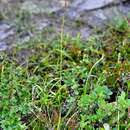en
names in breadcrumbs


Carex vaginata is a species of sedge known by the common name sheathed sedge.
This sedge produces stems up to 60 centimeters tall, growing from a long rhizome. The stem just below the inflorescence is sheathed in the base of the bract, the characteristic that gives the plant its name. The inflorescence contains a terminal spike and usually at least one lateral spike. The plant reproduces by seed and by sprouting from the rhizome and the stolons, and from buds at the bases of the stems.[1][2] Leaves 0.7-2.8 cm wide.[3]
It has a circumboreal distribution, occurring throughout the northern latitudes of the Northern Hemisphere. It occurs in Alaska, throughout most all of Canada to Greenland and in Eurasia. In North America it occurs as far south as Minnesota and New York.[1][3][4]
This sedge grows in many types of moist and wet habitat. It is present on tundra and in boreal forests. It grows in sandy, calcareous, and acidic, peaty soils.[1] It may be found growing in snow, which might help to protect it from dry and cold conditions.[5]
In North America it is considered widespread, abundant and secure[6]. On the international IUCN red list is has most recently been assessed to be least concern (LC)[7].
Carex vaginata is a species of sedge known by the common name sheathed sedge.